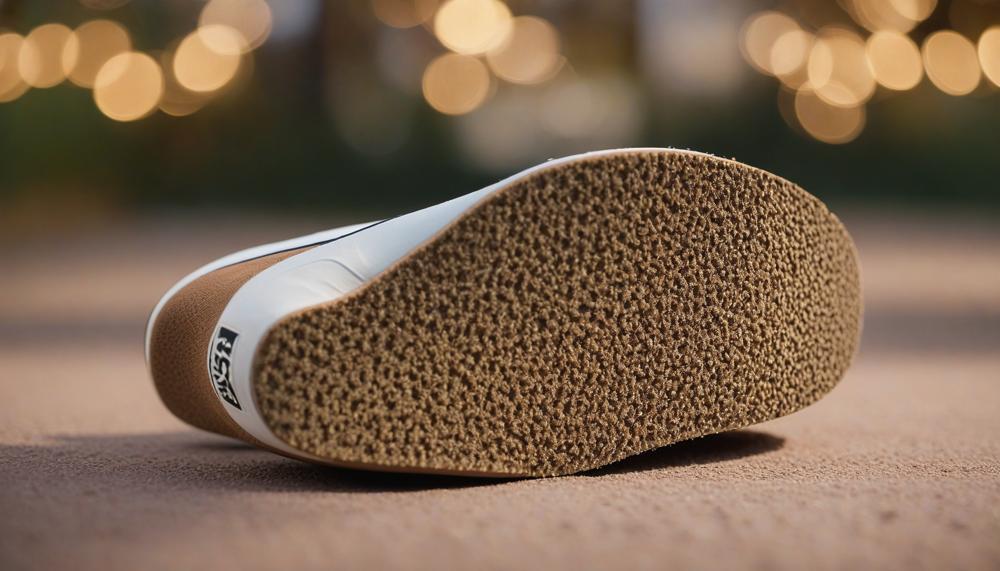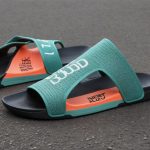The bottom of a shoe is commonly referred to as the sole. This seemingly simple part of your footwear carries more significance than you might initially think. It’s not just a barrier between your feet and the ground; the sole is pivotal in providing comfort, traction, and even affecting your posture and gait.
Whether it’s the thick, cushioned soles of running shoes or the sleek, leather soles of dress shoes, each type serves a specific purpose and reflects meticulous design and engineering.
Key takeaways about the sole of a shoe include:
- Functionality and Comfort: Soles absorb impact and provide cushioning, reducing stress on your feet and joints.
- Material Matters: Soles can be made from a variety of materials including rubber, leather, and synthetic compounds, each offering different benefits.
- Impact on Performance: The design of a sole can enhance athletic performance, improve grip and stability, and complement different styles of walking or running.
Understanding the structure and purpose of shoe soles can greatly enhance your appreciation of footwear and guide you in choosing the right pair for your needs. Stay tuned to discover more about how the evolution of sole technology might just be the unsung hero of your daily comfort and mobility.
What is an outsole?
Contents
The outsole is the external bottom part of a shoe that makes direct contact with the ground. This component is pivotal for cushioning, stability, and preventing wear and tear on the foot itself. Its design includes various materials such as rubber or synthetic compounds, which are selected based on their durability and grip qualities. The structure and substance of the outsole play a critical role in how it absorbs impact and provides traction, making it essential for various activities, particularly running.
The significance of a well-crafted outsole cannot be understated. It supports the foot by reducing the stress on the heel, arch, and toes during movement, while also providing a barrier that shields the foot from sharp objects and rough surfaces. Moreover, the outsole helps to stabilize the foot, aiding in preventing slips and falls by offering sufficient traction in different environments. This combination of protection, support, and durability helps to prevent injuries and enhances the overall effectiveness of the shoe.
To further illustrate, consider the following table which details key functions of the outsole and their benefits:
| Function | Material | Benefit |
| Impact absorption | Rubber, Foam | Reduces stress on joints |
| Traction | Textured Rubber | Prevents slipping |
| Durability | Thick Rubber | Long-lasting wear |
Each aspect of the outsole design is thoughtfully engineered to meet specific performance needs and ensure that the shoe not only fits comfortably but also responds well during various activities.
What is a midsole?
A midsole is an integral component of most shoes, nestled between the outsole and the upper part. Its primary function is to cushion the foot, absorb shock, and enhance overall foot support during various activities. This layer is crucial, especially for footwear designed for sports or extensive walking, as it mitigates the impact on the feet, ankles, and legs.
Functionality and Importance:
- Cushioning: The midsole acts as a buffer, softening the impact when the foot strikes the ground, thereby preventing discomfort and potential injuries.
- Support: It provides structural support to the shoe and helps maintain proper foot alignment, which is vital for balance and correct walking or running technique.
- Shock Absorption: Essential for reducing the stress on joints and bones during high-impact activities like running or jumping.
Materials and Variability:
- Materials Used: Common materials for midsoles include EVA (Ethylene Vinyl Acetate), which is lightweight and has good cushioning properties, and Polyurethane, known for its durability and excellent support features.
- Variations for Specific Needs: Different activities require different types of midsole support and cushioning. For instance, runners may need more cushioned and responsive midsoles compared to what is required for everyday casual shoes.
| Component | Function | Common Materials |
| Midsole | Cushioning, Support, Shock Absorption | EVA, Polyurethane |
| Comparison with Outsole | Less durable but more cushioning | N/A |
What is an insole?
An insole, also known as a shoe insert or footbed, is a removable layer inside a shoe that offers additional comfort, support, and cushioning to the foot. Typically crafted from materials like foam, gel, or a combination of both, insoles are designed to fit within the shoe, sitting atop the midsole which we discussed previously.
Insoles play a crucial role in the overall structure and function of a shoe’s bottom by providing several key benefits:
- Comfort and Cushioning: Insoles enhance the shoe’s comfort by offering extra padding, reducing the impact on the feet during activities such as walking or running.
- Support and Stability: They help in maintaining proper foot alignment, which in turn supports the ankle and reduces strain on other joints.
- Shock Absorption: Insoles can mitigate the shock experienced by the feet, which is particularly beneficial during high-impact activities.
- Improved Foot Health: By aligning the foot into a more natural position, insoles can prevent and alleviate pain associated with various foot conditions.
Best Footwear for Traveling in Europe
The most recommended footwear for traveling in Europe, ensuring both comfort and durability, are sneakers and ankle boots. These choices meld practicality with style, perfectly catering to the diverse terrains and weather conditions prevalent across European cities.
- Sneakers: Ideal for prolonged walks on cobblestone streets, sneakers with cushioned insoles and good arch support provide essential comfort. Opt for styles that are sleek and versatile to transition smoothly from daytime tours to evening outings.
- Ankle Boots: These are suitable for variable weather conditions, offering durability and protection. Look for boots with a sturdy sole and water-resistant material to handle both urban explorations and more rugged landscapes.
Best Work Boots for Flat Feet
If you have flat feet, selecting work boots that cater specifically to your condition is essential to ensure comfort and support throughout your workday. Here are key features to prioritize when choosing boots:

- Arch Support: Crucial for distributing pressure more evenly across your feet.
- Cushioning: Enhances comfort, especially under the heel and forefoot, to absorb shocks.
- Stability: A good pair of boots will offer stability, preventing your feet from rolling inwards.
- Durability: High-quality materials that withstand rough conditions are vital.
How to Break in New Shoes
The duration required to break in a new pair of shoes varies based on several factors including the shoe type and usage. For running shoes, which typically have more specific demands due to the stress of running, it commonly takes between 5-10 miles of wear to be adequately broken in.
Key Steps for Breaking in New Shoes:
Initial Fit
Ensure shoes fit well from the start, feeling snug but not tight.
Gradual Introduction
Begin by wearing your new shoes around the house to adapt the material to your foot’s shape without undue stress.
Incremental Use
Gradually increase usage; start on a treadmill or a light jog, then transition to your typical running environment.
Detailed Break-in Periods by Shoe Type:
| Shoe Type | Typical Break-in Period | Recommended Activities During Break-in |
| Running Shoes | 5-10 miles | Wearing around house, treadmill, light jogs |
| Leather Dress Shoes | 1-2 weeks | Short walks, wear with thicker socks |
| Casual Sneakers | 3-5 days | Day-to-day wear |
To ensure a smooth transition into new shoes, especially when trying a new model, a break-in period of 2-3 weeks is advised, following the above incremental steps. This careful approach helps to mold the shoe to the contours of your feet and can significantly reduce the risk of discomfort or injury.
Men’s to Women’s Shoe Size Conversion
To convert men’s shoe sizes to women’s shoe sizes in the US, simply add 1.5 to the men’s size to find the corresponding women’s size. This conversion helps match the shoe lengths as men’s sizes are typically labeled 1.5 sizes smaller than women’s.
For example, a men’s US size 7 would be equivalent to a women’s US size 8.Here’s a quick conversion table for some common sizes:
| Men’s US Size | Women’s US Size | Difference |
| 6 | 7.5 | +1.5 |
| 7 | 8.5 | +1.5 |
| 8 | 9.5 | +1.5 |
| 9 | 10.5 | +1.5 |
| 10 | 11.5 | +1.5 |
Keep in mind, this conversion formula holds true primarily for athletic shoes and many casual shoes.
For high-heeled shoes, variations might be more noticeable due to different style cuts and designs, so it’s always a good idea to try on the shoes whenever possible or check the specific brand’s size chart for more accuracy.
Conclusion
Navigating the multifaceted world of footwear, it becomes clear that the bottom of a shoe is more than just a piece that touches the ground—it’s a foundation of functionality and innovation. Dubbed the sole, this essential component is crafted not only to protect and provide comfort but also to enhance the performance of every step you take.
From the shock-absorbing layers of a running shoe’s thick soles to the refined, ground-gripping surfaces of dress shoes, the sole’s role is crucial. Different materials like rubber, leather, and advanced synthetics come together in a symphony of design aimed at improving your walking or running experience, minimizing joint stress, and boosting your overall biomechanics.
Moreover, the sole’s evolution over time highlights its pivotal role in athletic and daily activities. It underpins your posture, impacts your gait, and adapts to various terrains, making it a silent hero in the narrative of your daily movements. By understanding the sole’s complex architecture—from the rugged outsole that meets the pavement, to the supportive midsole, and up to the cushioning insole—you gain a deeper appreciation for the craftsmanship behind each pair of shoes, ensuring you make wise choices in your footwear journey.






